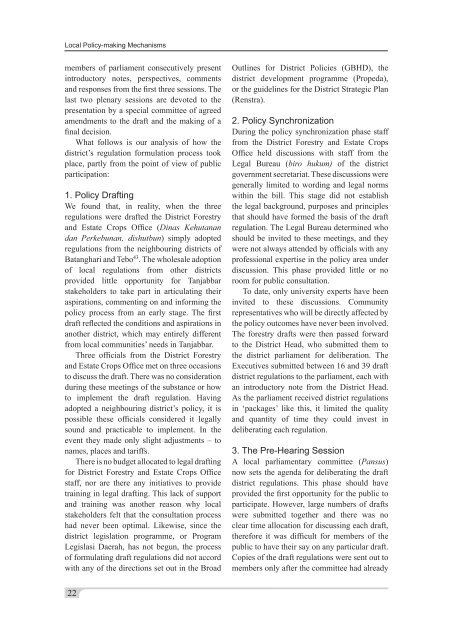Local policy-making mechanisms - Forest Climate Center
Local policy-making mechanisms - Forest Climate Center
Local policy-making mechanisms - Forest Climate Center
You also want an ePaper? Increase the reach of your titles
YUMPU automatically turns print PDFs into web optimized ePapers that Google loves.
<strong>Local</strong> Policy-<strong>making</strong> Mechanismsmembers of parliament consecutively presentintroductory notes, perspectives, commentsand responses from the first three sessions. Thelast two plenary sessions are devoted to thepresentation by a special committee of agreedamendments to the draft and the <strong>making</strong> of afinal decision.What follows is our analysis of how thedistrict’s regulation formulation process tookplace, partly from the point of view of publicparticipation:1. Policy DraftingWe found that, in reality, when the threeregulations were drafted the District <strong>Forest</strong>ryand Estate Crops Office (Dinas Kehutanandan Perkebunan, dishutbun) simply adoptedregulations from the neighbouring districts ofBatanghari and Tebo 43 . The wholesale adoptionof local regulations from other districtsprovided little opportunity for Tanjabbarstakeholders to take part in articulating theiraspirations, commenting on and informing the<strong>policy</strong> process from an early stage. The firstdraft reflected the conditions and aspirations inanother district, which may entirely differentfrom local communities’ needs in Tanjabbar.Three officials from the District <strong>Forest</strong>ryand Estate Crops Office met on three occasionsto discuss the draft. There was no considerationduring these meetings of the substance or howto implement the draft regulation. Havingadopted a neighbouring district’s <strong>policy</strong>, it ispossible these officials considered it legallysound and practicable to implement. In theevent they made only slight adjustments – tonames, places and tariffs.There is no budget allocated to legal draftingfor District <strong>Forest</strong>ry and Estate Crops Officestaff, nor are there any initiatives to providetraining in legal drafting. This lack of supportand training was another reason why localstakeholders felt that the consultation processhad never been optimal. Likewise, since thedistrict legislation programme, or ProgramLegislasi Daerah, has not begun, the processof formulating draft regulations did not accordwith any of the directions set out in the BroadOutlines for District Policies (GBHD), thedistrict development programme (Propeda),or the guidelines for the District Strategic Plan(Renstra).2. Policy SynchronizationDuring the <strong>policy</strong> synchronization phase stafffrom the District <strong>Forest</strong>ry and Estate CropsOffice held discussions with staff from theLegal Bureau (biro hukum) of the districtgovernment secretariat. These discussions weregenerally limited to wording and legal normswithin the bill. This stage did not establishthe legal background, purposes and principlesthat should have formed the basis of the draftregulation. The Legal Bureau determined whoshould be invited to these meetings, and theywere not always attended by officials with anyprofessional expertise in the <strong>policy</strong> area underdiscussion. This phase provided little or noroom for public consultation.To date, only university experts have beeninvited to these discussions. Communityrepresentatives who will be directly affected bythe <strong>policy</strong> outcomes have never been involved.The forestry drafts were then passed forwardto the District Head, who submitted them tothe district parliament for deliberation. TheExecutives submitted between 16 and 39 draftdistrict regulations to the parliament, each withan introductory note from the District Head.As the parliament received district regulationsin ‘packages’ like this, it limited the qualityand quantity of time they could invest indeliberating each regulation.3. The Pre-Hearing SessionA local parliamentary committee (Pansus)now sets the agenda for deliberating the draftdistrict regulations. This phase should haveprovided the first opportunity for the public toparticipate. However, large numbers of draftswere submitted together and there was noclear time allocation for discussing each draft,therefore it was difficult for members of thepublic to have their say on any particular draft.Copies of the draft regulations were sent out tomembers only after the committee had already22

















